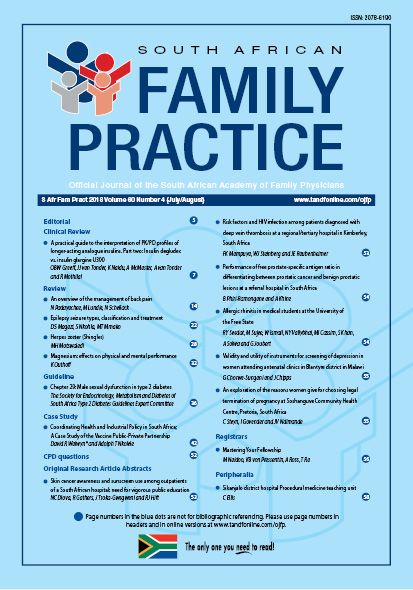Validity and utility of instruments for screening of depression in women attending antenatal clinics in Blantyre district in Malawi
Keywords:
Antenatal, depression, screening instrument, utility, validity
Abstract
Introduction: Screening instruments should be brief, valid and easy to use if they are to be useful in a busy antenatal clinic in low-resource settings. A short instrument can be used in a busy antenatal clinic in combination with a more detailed instrument once referred. This study aimed at assessing the validity of a range of depression screening instruments and to test the utility of combining these instruments for use in antenatal clinics in Blantyre district, Malawi. Methods: This was a sensitivity analysis study using a sub-sample of 97 pregnant women drawn from a cross-sectional study (sample size = 480) that was screening for depression in eight antenatal clinics. Data from the cross-sectional study for the 97 pregnant women on the 3-item screener, Edinburgh Postnatal Depression Scale (EPDS), Hopkins Symptoms Checklist-15 (HSCL-15) and Self-Reporting Questionnaire (SRQ), was compared with a gold standard, the Mini International Neuropsychiatric Interview (MINI). Sensitivity, specificity and area under curve (AUC) were calculated to test for validity of the instruments. The utility of various combinations of the instruments was tested using the compensatory, conjunctive, probability and sequential rules. Results: The 3-item screener, EPDS, HSCL-15 and SRQ were valid instruments for screening antenatal depression. Sequential combination of the 3-item screener and SRQ had superior discriminant ability over similar combinations of the 3-item screener and either EPDS or HSCL-15 (sensitivity = 78%, specificity = 88%, AUC = 0.885). Discussion: The 3-item screener, EPDS, HSCL-15 and SRQ are valid instruments for screening depression in local antenatal clinics. The sequential combination of the 3-item screener and SRQ may be a practical, accurate and suitable method for multistage screening of depression in antenatal clinics in Blantyre district, Malawi. (Full text of the research articles are available online at www.medpharm.tandfonline.com/ojfp) S Afr Fam Pract 2018; DOI: 10.1080/20786190.2018.1432136
Published
2018-08-28
Section
Research Articles
By submitting manuscripts to SAFP, authors of original articles are assigning copyright to the South African Academy of Family Physicians. Copyright of review articles are assigned to the Publisher, Medpharm Publications (Pty) Ltd, unless otherwise specified. Authors may use their own work after publication without written permission, provided they acknowledge the original source. Individuals and academic institutions may freely copy and distribute articles published in SAFP for educational and research purposes without obtaining permission.

